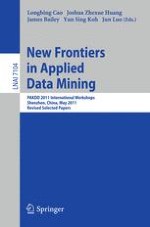This book constitutes the thoroughly refereed post-conference proceedings of five international workshops held in conjunction with PAKDD 2011 in Shenzhen, China, in May 2011: the International Workshop on Behavior Informatics (BI 2011), the Workshop on Quality Issues, Measures of Interestingness and Evaluation of Data Mining Models (QIMIE 2011), the Workshop on Biologically Inspired Techniques for Data Mining (BDM 2011), the Workshop on Advances and Issues in Traditional Chinese Medicine Clinical Data Mining (AI-TCM 2011), and the Second Workshop on Data Mining for Healthcare Management (DMGHM 2011). The book also includes papers from the First PAKDD Doctoral Symposium on Data Mining (DSDM 2011). The 42 papers were carefully reviewed and selected from numerous submissions. The papers cover a wide range of topics discussing emerging techniques in the field of knowledge discovery in databases and their application domains extending to previously unexplored areas such as data mining based on optimization techniques from biological behavior of animals and applications in Traditional Chinese Medicine clinical research and health care management.
